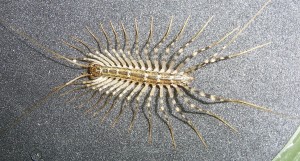“House Centipedes” Are At Home in Your Home
By Chris Williams on August 4, 2015.
My daughter brought me a very strange bug with lots of really long quivering legs. It’s got more than 8 legs so I guess it’s not an insect or even a spider. I’m thinking it’s some kind of centipede or millipede.
J. C., Chelmsford, MA

House Centipede
I think your bug might be a house centipede, especially if your daughter found it inside. Both centipedes and millipedes have lots of paired legs, but only the house centipede has really long legs. I heard someone say that it looks like a pair of false eyelashes glued back to back!
Many species of centipedes are common around home foundations where they are predators on insects, spiders, snails, earthworms, and other small creatures. They occasionally end up inside our homes. One type of centipede, the house centipede, is more specialized for indoor living. In fact, it’s the only centipede that can successfully reproduce indoors.
The House Centipede is All Legs
The house centipede is dirty yellow in color with 3 darker stripes down its back. While other centipedes have legs that are all of the same size, the house centipede has 15 pairs of legs that increase in length from the front to the back of the body. It actually uses its back legs to lasso and capture prey. It’s only about 1 to 1-1/2 inches long when full grown, but the long legs and very long antennae make the house centipede appear much larger. If you attempt to smash or capture a house centipede, the legs break off easily and will continue to twitch!
Like all centipedes, the house centipede prefers damp areas with higher humidity and is usually found in crawlspaces or basements, or in laundry rooms or bathrooms, often trapped in sinks or bathtubs. House centipedes move quickly and can climb walls. They hide during the day and hunt for their prey at night.
Centipedes May Not Be Your Only Pest Problem
House centipedes can be controlled by an exterminator’s visit to your home but we like to point out that the presence of lots of house centipedes means that: (1) parts of your home might be too damp (which house centipedes like), and (2) you might have other pest problems to consider as well. The centipedes wouldn’t be there if there wasn’t plenty of food for them in the form of either roaches, silverfish, clothes moths, carpet beetles, sowbugs, crickets, or other insects. Give Colonial Pest a call. We can positively identify your specimen, then inspect and treat your home for house centipedes and their prey.
Photo Credit: Dilcoe at English Wikipedia [Public domain], via Wikimedia Commons